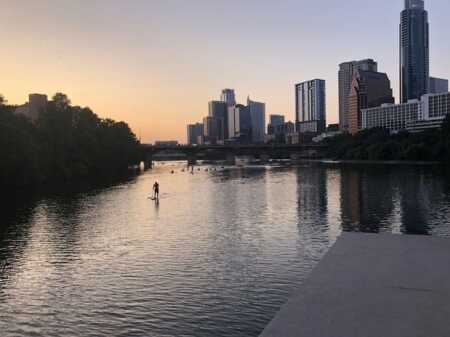A robust public/private partnership could further enable a bike trail and pedestrian boardwalk that bridges the lingering cultural divide between the east and west sides of Austin, Texas, according to the recommendations made by a ULI Advisory Services panel in August.
Interstate 35 cuts through the heavily used Ann and Roy Butler Hike-and-Bike Trail, separating east Austin from downtown Austin. Historically, I-35 has also been a dividing line between disadvantaged communities east of the interstate and more affluent communities to the west. In recent years, east Austin has increasingly gentrified but the area remains a physical and cultural base for many people of color.
During a ULI Advisory Services panel discussion at Austin’s Central Library, Matt Norris, a senior manager with the Institute’s Center for Sustainability and Economic Performance, suggested that strengthening the ties between the Austin Parks and Recreation Department and the nonprofit Trail Foundation, which supports the Butler Hike-and-Bike Trail, could connect neighborhoods and people on both sides of the 10-mile (16 km) trail.
“We see that the trail already physically connects people on both sides of I-35, but we believe that there’s a greater opportunity for it to connect cultures on both sides—from the east side to the west side and beyond,” Norris said.
Norris said that this sort of connection could introduce more people, particularly younger people, to “truly meaningful” experiences with nature.
“Research shows that youth from historically underserved areas often can’t access nature. There’s a lot of barriers—to cost, to transportation, to feeling welcome,” he said.
Norris was among nearly a dozen land use and urban planning experts who traveled to Austin to study ways that the Austin Parks and Recreation Department and the nonprofit Trail Foundation can join forces on operating and enriching the Butler Hike-and-Bike Trail. The trail draws more than 4.4 million visitors a year.
Julie Underdahl, an independent consultant in Denver who chaired the ULI Advisory Services panel, said the collaborative effort could help overcome racism that has hindered how the trail is used and improved.
“The trail is so much more than a trail,” Underdahl said. “It plays a much bigger role in the community, and in your hearts and minds. In an era of big change, the trail reminds you of either why you live here or why you came here.”
Underdahl is former president and CEO of Denver’s Cherry Creek North Business Improvement District.
The Advisory Services panel in Austin was conducted in conjunction with the 10-Minute Walk Campaign, a national initiative seeking to ensure that residents of urban neighborhoods in the United States have access to a high-quality park within a 10-minute walk of their homes.
Panel member Edward Henley III, founder, principal, and project executive at Pillars Development in Nashville, Tennessee, recommended that the Austin parks department and the Trail Foundation move toward a tighter bond through a pilot project. Under this project, the long-vacant Nash Hernandez Building at Festival Beach Park in east Austin would be jointly used as a venue for activities such as community meetings, concerts, and fundraising events. Festival Beach sits on the east end of the Butler Hike-and-Bike Trail and on the north shore of Lady Bird Lake.
Norris indicated that Grand Park in Los Angeles could be a template for overall enhancement of the Butler Hike-and-Bike Trail. He said that the renovated 12-acre (5 ha) park reflects L.A.’s diverse cultures, thanks in part to visioning sessions conducted in Armenian, English, Japanese, Korean, and Spanish.
To undertake a Grand Park–like evolution, ULI panelist Shane Farthing, director of economic and community development for the city of Martinsburg, West Virginia, said that the Austin parks department and the foundation need to:
- Define a shared vision.
- Set basic expectations for public and private roles.
- Establish trust.
- Leave room for flexibility.
- Maintain communication and accountability.
Henley said that the collaboration could include agreements on items such as capital projects, maintenance and repairs, conservation, and community engagement. Whatever they decide to do, he urged the parks department and the foundation to avoid cutting corners in formalizing their partnership.
“Shortcuts are not a good foundation for partnerships and long-term success,” Henley said. “There are challenges now, and there will be challenges ahead, but opportunities and steps to follow—when utilized well—will set the groundwork for success.”
Heidi Anderson, executive director of the Trail Foundation, said that the ULI panel’s insights validate her organization’s already recognized belief that it should extend its partnership with the Austin parks department—a partnership that promises to advance the trail’s status as a “hub” connecting several trail systems in Austin.
“We really want to do more to bring people into the Butler Hike-and-Bike Trail and Lady Bird Lake area who don’t have access now,” Anderson said.
To increase that access, the foundation has identified nine infrastructure priorities (out of 15 infrastructure priorities in total) that will benefit the section of the trail east of I-35, Anderson said. In east Austin, a boardwalk along Lady Bird Lake that opened in 2014 closed a gap in the trail, completing its 10-mile (16 km) loop.
Underdahl said that cooperation between the parks department and the foundation is not an issue, since they are already working together. Rather, Underdahl said, fostering their partnership boils down to how to carry out the ULI panel’s recommendations for a trail that she described as a “respite” and “oasis.”
Parks are essential to the physical, environmental, and economic health of people and communities. 10 Minute Walk is a movement dedicated to improving access to safe, high-quality parks and green spaces in cities—large and small—throughout the United States. Led by the Trust for Public Land, in partnership with the National Recreation and Park Association, and the Urban Land Institute, 10 Minute Walk is working to create a world in which, by 2050, all people live within a 10-minute walk of a park or green space.








